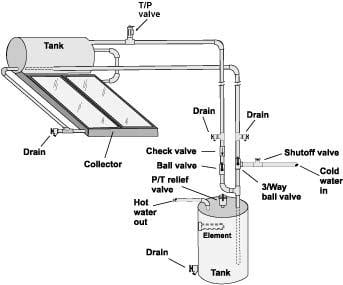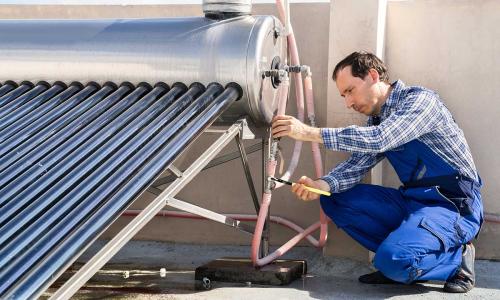Table of Contents
Today, most American homes and businesses use natural gas, electricity, or oil to provide them with hot water. The amount of energy required to meet our hot water needs is not insignificant. According to the US Department of Energy (DOE), heating water today accounts for up to 14 percent of the average household's energy use, and nearly four percent of total US energy consumption. With electricity and natural gas prices continuing to rise, the costs of having a constant supply of hot water can really add up.
Solar water heating (SWH) technologies are a simple, reliable, and cost-effective method of harnessing the sun's energy to provide for the energy needs of homes and businesses. Simply stated, SWH systems collect the energy from the sun to heat air or a fluid. The air or fluid then transfers solar heat directly or indirectly to your water supply.
Though these systems have been in use for centuries, with today's technological advances, SWH technologies can be operated efficiently and affordably in any climate. Systems are specifically designed for various climatic and geographical areas of the country. Regions with temperatures that fall below freezing require the use of an indirect or drain-back system, while warmer, sunnier climates can use a direct system, which directly heats the water to be used.
SWH systems also provide an important opportunity to reduce our nation's growing demand for energy from fossil fuels. By installing a SWH system, a typical household can meet 50 to 80 percent of their hot water needs. In warm and sunny climates like Hawaii, a SWH unit can meet 100 percent of a household's hot water needs. Reduced demand for fossil fuels will improve the environment by reducing air and water pollution as well as the heat-trapping gases that cause global warming. And though they cost a little bit more up front to install, a SWH system will save consumers money in the long run as the fuel source (the sun's energy) will always be free.
Currently there are more than 300,000 SWH units installed across the United States (excluding swimming pool applications). While the number of installations continues to grow by the thousands every year, there still exists an enormous untapped market with great potential for reducing a significant portion of our nation's energy use.

Basics of solar water heating
The most popular type of solar collector for water heating is the flat panel design (other types include evacuated-tube, concentrating, and integral collector storage). A flat panel collector is an insulated weatherproof enclosure with an absorber plate, flow tubes, and a transparent cover. The transparent cover allows solar energy to pass through and be absorbed by the absorber and flow tubes. The heat generated is then transferred to the fluid circulating through the flow tubes.
Once the solar energy is collected, it is commonly employed with the pumped indirect SWH system. Best suited for colder climates, an indirect system pumps heat-transfer fluids (usually a non-toxic propylene glycol-water antifreeze mixture) through collectors, and then transfers the heated fluid from the collectors to a storage tank. Heat exchangers transfer the heat from the fluid to the household water stored in the tanks. Water stored within the tank is then heated when the fluid passes through a heat exchanger located inside the storage tank. Antifreeze fluid is used to prevent collector piping from freezing and allow for the maximum transfer of heat from the solar collector to the storage tank. Many indirect system designs also incorporate an external heat exchanger.
The drain-back system is another common cold climate system. With this system, the water in the collectors and exposed piping drains into an insulated drain-back reservoir tank each time the pump shuts off. Removing all water from the collectors and piping when the system is not collecting heat provides a fail-safe method of ensuring that collectors and the collector loop piping never freeze.
In warmer climates, direct systems are more commonly used. The direct system circulates potable water directly through the solar collector into the storage tank. In other words, the water that is used in the house is the same water that has circulated through the solar collector. These systems incorporate various strategies to control the operation of the circulating pump, which can include photovoltaic or differential controllers.
Passive direct systems are also used in warmer climates. The unique characteristic of these systems is that they do not use pumps or other electrical components, thereby providing a simple and reliable system. The most common passive systems are the thermosiphon (see diagram below) and integral collector storage systems. Indirect thermosiphon systems could also be used in colder climates.
Solar water heating systems typically cost between $2,000 and $5,000 installed, depending on the type and size of system. Some state governments and local utilities may offer rebates or other financial incentives to help reduce the costs (see below). With regular inspection, the system will operate for 20 to 30 years with minimal maintenance and costs.
Solar water heating for swimming pools
In order to maintain swimming pool temperatures during different seasons, homeowners and businesses may want to invest in solar water heating systems. Conventional natural gas and electric heaters are available for heating swimming pools, but they can be costly and inefficient. By comparison, SWH systems for swimming pools are cost competitive, primarily because the fuel source is free and the operating costs are low. A typical solar pool heating system can range from $2,000 to $4,000, depending on variable factors such as ease of installation, state codes and safety requirements, and access to financing. The investment, however, is well worth the effort as a SWH system for a pool can pay for itself in just 2 to 4 years when you account for the energy bill savings. Solar pool heating systems are also highly reliable and generally maintenance free.
Solar heating systems are available for both in-ground and aboveground pools. They are effective because swimming pools require a low temperature heat source, which a relatively small solar collector can easily provide. Most SWH systems for pools include a solar collector, filter, pump, and flow control valve. Pool water is first pumped through the filter. Then it flows through the solar collector where it is heated before returning to the pool. Some systems offer manual automatic sensor valves that can send water through the collector when the collector temperature is greater than the pool temperature, or bypass the collector when its temperature is similar to the pool water. In particularly hot climates, passing pool water through the solar collectors during the evening hours can serve as a cooling mechanism.
Utility and policy support for solar water heating systems
Some electric utility companies have recognized the generation-offset capability of SWH and have designed programs to increase demand for their installation. For example, from 1996 to 2004 the Hawaiian Electric Company (HECO) saw more than 25,000 SWH systems installed within its customer base. These systems reduced the utility's demand by a total of 12.7 megawatts—enough electricity to power approximately 18,000 typical US homes.
However the potential for SWH usage is not limited to temperate climates like Hawaii. In Oregon, SWH systems qualify for tax credits and local utilities are providing zero interest loans for installation. To see what programs and incentives are available in your area, check the North Carolina Solar Center's Database of State Incentives for Renewable Energy.
SWH also has a role to play in utility "green" energy programs. For example, Lakeland Electric, a municipal utility in Florida, has a unique arrangement for its customers. The utility installs and owns about 60 residential SWH systems in the community. The utility meters the SWH output and bills customers for the solar-heated water. The utility retains ownership of the "green" attributes (referred to as renewable energy certificates or RECs) associated with the solar equipment. In October 2004, Lakeland sold some of these credits to another Florida utility for use in its green pricing program.
Resources for more information
Department of Energy's Office of Energy Efficiency and Renewable Energy (EERE)—Solar Hot Water Systems Website
EERE's Consumer's Guide to Solar Hot Water Systems(PDF)
Florida Solar Energy Center—General Information on solar hot water systems for homes and swimming pools
North Carolina Solar Center—Detailed information about solar technologies (including solar hot water)
Solar Energy Industries Association—Includes a state-by-state directory of solar installers, retailers, and contractors




